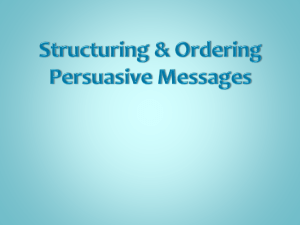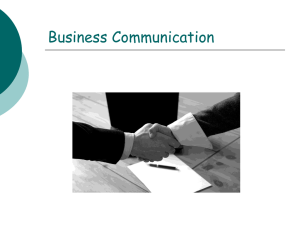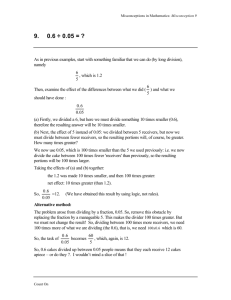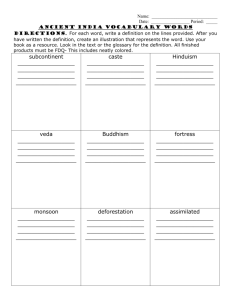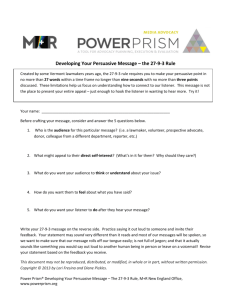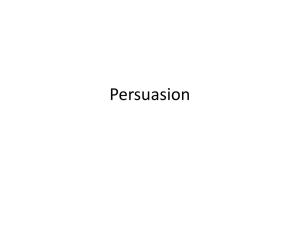Message Structure
advertisement
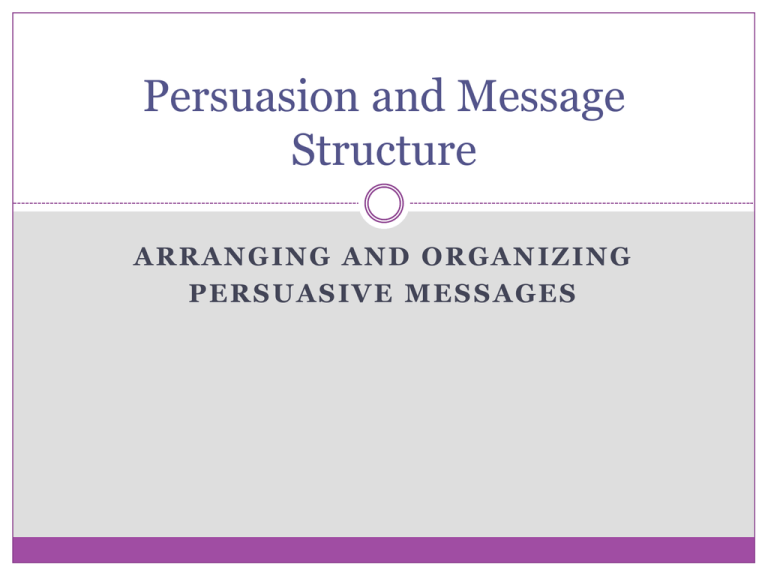
Persuasion and Message Structure ARRANGING AND ORGANIZING PERSUASIVE MESSAGES Cicero’s five canons of speech Inventio: the invention and discovery of arguments Elocutio: eloquence, fluency, command of language, and language style Memoria: memory, mnemonic devices Pronuntiatio: delivery factors, rate, pitch, voice quality, and articulation Dispositio: the effective and orderly arrangement of ideas explicit vs. implicit conclusions: which should you use? Is it better to spell things out for the listener? The source might be seen as more frank, forthright Less risk the listener would reach the wrong conclusion Or let the listener figure it out for him or herself? Less condescending, patronizing Less risk the message would be perceived as restricting the listener’s free choice So what I’m asking you to do is… explicit vs. implicit conclusions: draw your own conclusions Generally speaking, implicit conclusions work best more participatory, involving greater conclusion comprehension self-generated conclusions less risk of psychological reactance especially true for receivers with high involvement (Cruz, 1998) also better with hostile audiences or counterattitudinal messages Exceptions to the general rule: difficult, complex messages messages that could be easily misconstrued listeners with little knowledge, low involvement quality vs. quantity of arguments the role of receiver “involvement” according to the ELM model Petty & Cacioppo (1984): for receivers with low involvement, it is the quantity of arguments that counts for receivers with high involvement it is the quality of arguments that counts. More than 100 scientific studies support the conclusion that global warming is a very real phenomenon quality vs. quantity of arguments When receivers have low involvement, quantity counts. When receivers have high involvement, quality counts. message repetition: “You can say that again” Mere exposure effect: repeated exposure to an unfamiliar stimulus increases liking for the stimulus messages “grow on us” nonsense words, yearbook pictures, geometric shapes corporate logos, slogans, brand names repetition can facilitate attention, awareness, learning, retention the “magic number” of exposures is three the problem of “wear out”: excessive repetition can backfire primacy versus recency effects the primacy effect in impression formation (Asch, 1946) Zunin (1972) first impressions are solidified within the first four minutes of interaction with a stranger primacy vs. recency and the time interval between interaction primacy effect if two messages follow back to back recency effect if two messages are separated by a time delay message order (internal organization) climax order: saving the best for last anticlimax order: putting your best material first pyramidal order: sandwiching the best material in the middle conclusion: pyramidal scheme is the least effective put your best ideas, arguments, and information first or last, but not in the middle one-sided versus two-sided messages two-sided messages are almost always more persuasive (Allen et al, 19990) a “refutational” approach is required, e.g., directly refuting, not merely acknowledging, opposing arguments exceptions; when receivers already agree are easily confused are uneducated or unintelligent will not be exposed to the opposing side later on more about one-sided vs. two-sided messages (Allen, 1991) the persuasion hierarchy: (from most to least persuasive) 1. two-sided, refutational messages 20% more effective overall than onesided messages 2. one-sided messages 20% more effective than two-sided, nonrefutational messages 3. two-sided, nonrefutational messages My opponent claims this plan is too costly, but in fact, this plan will save our company money, and pay for itself within 3 years. inoculation theory McGuire’s inoculation theory (1961, 1964) is based on a disease metaphor The theory in a nutshell: a small dose of the opposing position can increase resistance to subsequent influence attempts Especially applicable to “cultural truisms” cultural truisms are unquestioned beliefs that we take for granted, “givens.” analogous to a person being raised in a germ-free environment—increased susceptibility upon exposure (O’Keefe, 1990) inoculation is less effective on controversial topics how inoculation works Threat is the motivational trigger Threat motivates receivers to recognize the vulnerability of their attitudes and beliefs to potential challenges Threat motivates people to bolster their attitudes and beliefs Inoculation affords protection beyond the original arguments to new novel arguments types of inoculation refutational “same” versus “different” conditions It is the motivation to defend one’s beliefs, not the specific information provided, that bolsters resistance combining “supportive” and “refutative” approaches works even better than refutation alone Pfau (2004) “All in all, research indicates that inoculation is amazingly robust in conferring resistance to influence” Inoculation and comparative advertising 1970’s: noncomparative ads, e.g., “brand X” 1990’s: direct comparison advertising Approximately ½ of all ads use comparison advertising (Levy, 1987) Examples: pizza brands, rental car companies, long distance providers, pain relievers, allergy medicines Inoculation via comparison ads appears to be more effective for products with high involvement (Pfau,1992) forewarning: you better watch out... forewarning versus inoculation: forewarning merely warns a listener of an impending persuasive message (e.g. warning of persuasive intent) inoculation includes actual examples of the opposing arguments forewarning increases resistance to influence attempts receivers adopt a less receptive state of mind receivers may prepare defenses and rehearse counter-arguments a time interval is desirable (some say essential) to allow for counter-arguing to take place depends upon motivation and ability to disagree evidence: prove it to me Evidence use facilitates persuasion in a variety of settings (advertising, political campaigns, health messages) “The use of evidence produces more attitude change than no evidence” (Reynolds &Reynolds, 2002) Reinard (1991) “evidence appears to produce general persuasive effects that appear surprisingly stable” Quantity of evidence—most effective for receivers with low involvement Quality of evidence—most effective for receivers with high involvement more about evidence Citing evidence sources can increase a persuader’s credibility (O’Keefe, 1998) Evidence is more effective if the source is identified, and the source is highly qualified Statistical evidence is more effective if the underlying methodology is explained (how the numbers were gathered, how the study was done) Statistical versus anecdotal evidence Best to combine the two; begin with an example or case study, then use statistics to show the example is not atypical
